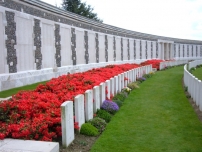| First Name: | James Aubrey | Last Name: | GEORGE | |
|---|---|---|---|---|
| Date of Death: | 21/09/1917 | Lived/Born In: | Pinner | |
| Rank: | Private | Unit: | East Surrey12 | |
| Memorial Site: | Tyne Cot Memorial, Belgium | |||
Current Information:Age-21 Born-Ware Enlisted-Mill Hill
Third Battle of Ypres This was a campaign fought between July and November 1917 and is often referred to as the Battle of Passchendaele, a village to the north-east of Ypres which was finally captured in November. It was an attempt by the British to break out of the Ypres salient and capture the higher ground to the south and the east from which the enemy had been able to dominate the salient. It began well but two important factors weighed against them. First was the weather. The summer of 1917 turned out to be one of the the wettest on record and soon the battlefield was reduced to a morass of mud which made progress very difficult, if not impossible in places. The second was the defensive arrangements of concrete blockhouses and machine gun posts providing inter-locking fire that the Germans had constructed and which were extremely difficult and costly to counter. For 4 months this epic struggle continued by the end of which the salient had been greatly expanded in size but the vital break out had not been achieved. The Battle of the Menin Road. 20th-25th September, 1917 After the disappointing opening battles of the last day of July and the middle of August, when very little had been gained but at great cost in casualties, a new approach was adopted for the next offensive against the Gheluvelt plateau which began on 20th September and became known as the Battle of the Menin Road. The task was handed over to General Plumer, commander of the Second Army, a more cautious leader who, rather than try to drive as deep as possible into the German line, was an advocate of 'bite and hold' tactics with limited advances of no more than 1,500 yards, based on overwhelming firepower and exhaustive preparation. These new tactics, which were significantly aided by a period of warm, dry weather, worked well and September and early October saw a decisive phase of Third Ypres in which the British gained the upper hand. At the same time that Plumer’s Second Army were hammering away at the German defences on the Gheluvelt plateau, Fifth Army also attacked in the northern part of the Ypres salient and they too made gains. At 5.40am on 20th September, 41st Division attacked from a position south of the Menin Road, through the northern part of Shrewsbury Forest with the Tower Hamlets Ridge as their objective. On the left of the divisional front, 122 Brigade had the 15th Hampshire and 18th King’s Royal Rifle Corps battalions in front, detailed to capture the Red and Blue Lines after which, the 11th Royal West Kent and 12th East Surrey battalions would continue the forward movement. The two battalions in front made good progress despite some fierce opposition and reached the Red and Blue lines. 12th East Surrey, following close behind 18th King’s Royal Rifle Corps helped in the consolidation of the Blue Line and then established outposts in front of this position as well as forming a defensive flank on their right. They remained in these forward positions until relieved on 23rd September during which time they were under constant shell fire as well as coming under fire from machine-guns and snipers firing from an enemy strongpoint on their right flank. Throughout this period their casualties mounted to over 300 killed, wounded or missing. One of those who did not survive this ordeal was James George. |
||||
| « Back to Search Results | ||||
| If you think any of the information shown here is incorrect, Click Here to submit your amends and comments | ||||




